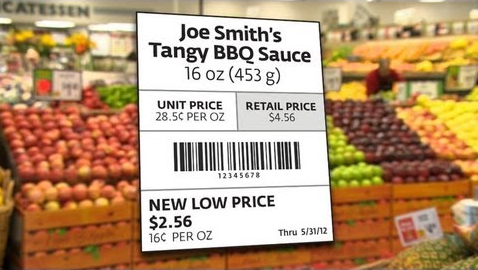Section 6-3: Unit Pricing
Section 6-3: Unit Pricing
Overview

 Unit pricing refers to the cost of a product or service per unit of measurement, allowing consumers to compare prices between different brands or quantities of the same product. Unit pricing is typically displayed alongside the total price on product labels or shelf tags in stores. It helps consumers make informed purchasing decisions by enabling them to assess the value and affordability of products based on their price per standard unit, such as per ounce, per pound, per liter, per piece, etc.
Unit pricing refers to the cost of a product or service per unit of measurement, allowing consumers to compare prices between different brands or quantities of the same product. Unit pricing is typically displayed alongside the total price on product labels or shelf tags in stores. It helps consumers make informed purchasing decisions by enabling them to assess the value and affordability of products based on their price per standard unit, such as per ounce, per pound, per liter, per piece, etc.
Here's how unit pricing works:
Standard Unit: The unit of measurement used for unit pricing depends on the nature of the product. For example, for packaged foods, unit pricing may be based on ounces, pounds, or individual servings, while for liquids, it may be based on liters or gallons.
Total Price: The total price represents the overall cost of the product. It's the amount that you would pay for the entire quantity of the product, as indicated on the product label or shelf tag.
Unit Price: The unit price is the cost per standard unit of measurement. It's calculated by dividing the total price by the quantity of the product in standard units. For example, if a 16-ounce jar of peanut butter costs $3.99, the unit price would be calculated as follows:
Unit Price = Total Price / Quantity = $3.99 / 16 ounces ≈ $0.249 per ounce
Comparisons: Unit pricing allows consumers to compare prices between different sizes or brands of the same product. By comparing the unit prices of similar products, consumers can determine which option offers the best value for money. For example, if two jars of peanut butter are priced at $3.99 for 16 ounces and $5.49 for 24 ounces, respectively, consumers can compare the unit prices to determine which option is more cost-effective.
Benefits: Unit pricing helps consumers make informed decisions, save money, and avoid overpaying for products. It also promotes price transparency and encourages competition among brands, leading to lower prices and better value for consumers.
Unit pricing is a valuable tool for consumers, enabling them to assess the true cost of products and make cost-effective purchasing decisions. By comparing unit prices, consumers can identify the most economical options and maximize their purchasing power.
Videos (Click on Image to View Videos)
Online Textbook Read Section 6-3: (Unit Pricing)
